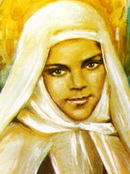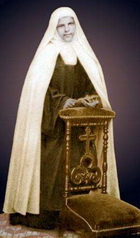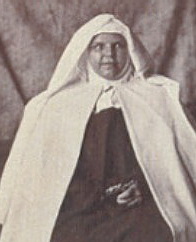We are coming up on the Memorial of Bl. Mariam of Jesus Crucified who founded the Carmels in Nazareth and Bethlehem. She is a beautiful saint who showed great devotion to Our Lady as well as Our Crucified Lord and the Holy Spirit, and overcame a myriad of obstacles to fulfill the Divine Will of Our Heavenly Father. Let us look to her to inspire and strengthen us on our spiritual journeys in Carmel, towards union with the Holy Three. Amen.
BLESSED MARY OF JESUS CRUCIFIED
Mariam Baouardy 1846-1878
Mariam Baouardy was born on January 5th 1846 at Ibillin, a village in the Holy Land near Nazareth. Her parents were George Baouardy and Mariam Shashyn, they were Greek Catholics in a predominantly Muslin area. They were both persecuted for their faith and George spent some time in prison. Their first 12 children, all boys, died in infancy so they decided to go on pilgrimage to Bethlehem, to beg Our Lady for a daughter and they promised to call her Mariam. Their prayers were answered when little Mariam was born, followed two years later by her only surviving brother, Paul. Mariam was baptised and confirmed when she was ten days old according to the Greek Catholic Rite. Sadly before she was three years old both her parents died from an infectious illness, within a few days of each other. When her father was dying he commended Mariam to the care of St. Joseph, looking lovingly at a picture of him, he said‘Great saint, here is my child; the Blessed Virgin is her mother; deign to look after her also; be her father’.
Mariam was taken to the home of a wealthy paternal uncle and Paul went to live with a maternal aunt but they never saw each other again. Mariam was treated kindly but surprised the family by her intense devotion to Our Lady. From the age of five she fasted every Saturday in her honour and she frequently gathered flowers to place before her icon. Mariam received her First Communion when she was eight, in spite of the hesitancy of the priest; she was unable to contain her longing for the Sacrament and went to up to receive with others. The priest accepted her and she said that Jesus came to her ‘as a child’.
Soon afterwards the family moved to Alexandria and when she was nearly thirteen Mariam’s uncle told her that he had arranged a marriage for her, according to the customs of the time. Mariam, who had already made up her mind that Jesus would be her only bridegroom, informed the family of her decision. Her uncle was so infuriated that he sent her to work as a servant in the kitchen. After a few months she decided to try to contact her brother and attempted to send him a message through a Muslim servant who was going to Galilee. When she told him her story her tried to make her deny her faith and because she refused he slashed her throat and dumped her body on the roadside, convinced that she was dead. Later doctors agreed that the wound inflicted on her should have caused her death, but Mariam telling of this event said that a nun in blue brought her to a cave, stitched her wound and gave her some delicious soup. Then she told her, ‘You will never see your family again you will go to France where you will become a religious. You will be a child of St. Joseph before becoming a daughter of St. Teresa. You will receive the habit of Carmel in one house, you will make your profession in a second and you will die in a third, at Bethlehem’. Mariam did not know who the ‘nun’ was at the time but she later believed that she was miraculously cured by Our Lady and all she said was fulfilled in Mariam’s life.
Mariam never saw her uncle again and her search for her brother was unsuccessful, but she spent an eventful few years working as a servant in various places and going on pilgrimage to Jerusalem, where she made a vow of chastity at the age of 15.When she was 18 Mariam was offered work with a Syrian family who lived in Marseilles. It was there that she entered the Sisters of St. Joseph of the Apparition, but after a two year postulancy she was asked to leave because she did not get enough votes to be accepted as a novice. This was because some of the sisters were disturbed by her mystical graces, which included ecstasies and the stigmata; some doubted her authenticity, although her prioress and novice mistress would have accepted her. In fact, Sr. Veronica, her novice mistress, was waiting for permission to transfer to the Carmel in Pau and she suggested to Mariam that she go with her. Mariam agreed and was accepted by the Carmel. They both entered there in June 1867. Mariam was given the religious name, Sr. Mary of Jesus Crucified.
Very soon Mariam’s mystical experiences became obvious as the stigmata manifested itself again that same year and later she was seen to levitate. Throughout her life she frequently fell into ecstasies. The Carmelites in Pau were able to accept this unusual phenomena, as they could see her genuine devotion and willing obedience.
Holy Spirit, inspire me.
Love of God, consume me.
To the right path lead me.
Mary my mother, look down upon me.
With Jesus, bless me.
From all evil, all illusion, all danger, preserve me.
In 1870 Mariam was one of a group of nuns from the Carmel of Pau who set out to found a Carmel in Mangalore, India. It was there that she made her Profession on November 21st 1871. Mariam had entered as a lay sister but when she received the habit she did so as a choir sister, although she had not wanted this herself and she asked to become a lay sister again while she was in India. Her mystical experiences continued to be a trial to her and some of the sisters in Mangalore thought that they were a sign of demonic possession so Mariam was ordered to return to France. Later the sisters realised their mistake and apologised profusely. Mariam replied, ‘All that has taken place was willed by Jesus. May His name be praised! It is God who has permitted everything’.
Mariam had returned to the Carmel of Pau in November 1872. Three years later she went to the Holy Land where she was instrumental in founding the Carmel at Bethlehem, Berthe Dartigaux, a young aristocrat from Pau made this possible by investing her entire fortune in the foundation. She went to Bethlehem herself with the seven nuns from Pau who set out to make the Foundation. Mariam was already planning to found another Carmel in Nazareth when she became ill. As the only sister who spoke Arabic, Mariam oversaw the workmen who were building the Carmel at Bethlehem and it was when she was carrying water to them that she fell and badly injured her arm. Very soon the wound became gangrenous and the infection affected her lungs and respiratory tract. Mariam knew she was dying.
Mariam had returned to the Carmel of Pau in November 1872. Three years later she went to the Holy Land where she was instrumental in founding the Carmel at Bethlehem, Berthe Dartigaux, a young aristocrat from Pau made this possible by investing her entire fortune in the foundation. She went to Bethlehem herself with the seven nuns from Pau who set out to make the Foundation. Mariam was already planning to found another Carmel in Nazareth when she became ill. As the only sister who spoke Arabic, Mariam oversaw the workmen who were building the Carmel at Bethlehem and it was when she was carrying water to them that she fell and badly injured her arm. Very soon the wound became gangrenous and the infection affected her lungs and respiratory tract. Mariam knew she was dying.
Early on August 26th 1878 she felt as if she was suffocating and she died at 10 past 5 in the morning, having uttered the words ‘My, Jesus, mercy.’
She is buried in the Carmel that she founded in Bethlehem and the inscription on her tomb reads:
‘Here in the peace of the Lord reposes Sister Mary of Jesus Crucified, professed religious of the white veil. A soul of singular graces, she was conspicuous for her humility, her obedience and her charity. Jesus, the sole love of her heart called her to Himself in the 33rd year of her age and the 12th year of her religious life at Bethlehem, 26 August 1878.’
Pope John Paul II declared Sister Mary of Jesus Crucified Blessed on November 13th 1983.
Her feast day is celebrated on August 25th.
She is buried in the Carmel that she founded in Bethlehem and the inscription on her tomb reads:
‘Here in the peace of the Lord reposes Sister Mary of Jesus Crucified, professed religious of the white veil. A soul of singular graces, she was conspicuous for her humility, her obedience and her charity. Jesus, the sole love of her heart called her to Himself in the 33rd year of her age and the 12th year of her religious life at Bethlehem, 26 August 1878.’
Pope John Paul II declared Sister Mary of Jesus Crucified Blessed on November 13th 1983.
Her feast day is celebrated on August 25th.
This photo shows
Sr. Mary of Jesus Crucified
(second from the left in the back row)
with the other foundresses of
the Carmel at Bethlehem.
It was taken before they left
the Carmel of Pau, near
the Pyrenees in France.
Sr. Mary of Jesus Crucified
(second from the left in the back row)
with the other foundresses of
the Carmel at Bethlehem.
It was taken before they left
the Carmel of Pau, near
the Pyrenees in France.
Taken from: http://carmelitesisters.ie/blessed-mary-of-jesus-crucified-miriam-baouardy/
Carmelite Prayer:
Merciful Father and God of all consolation, You guided, the humble daughter of the Holy Land, Blessed Mary of Jesus Crucified to contemplation of the mysteries of Your Son and You made her a witness of the charity and joy of the Holy Spirit. Grant us, through her intercession, to participate in the sufferings of Christ in order to exalt and rejoice in the revelation of Your glory. We ask this through our Lord, Jesus Christ, Your Son, Who lives and reigns with You and the Holy Spirit, One God, forever and ever. Amen.












